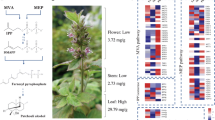Abstract
Withania somnifera (L.) Dunal (Family, Solanaceae), is among the most valuable medicinal plants used in Ayurveda owing to its rich reservoir of pharmaceutically active secondary metabolites known as withanolides. Withanolides are C28-steroidal lactones having a triterpenoidal metabolic origin synthesised via mevalonate (MVA) pathway and methyl-D-erythritol-4-phosphate (MEP) pathway involving metabolic intermediacy of 24-methylene (C30-terpenoid) cholesterol. Phytochemical studies suggest differences in the content and/or nature of withanolides in different tissues of different chemotypes. Though development of genomic resources has provided information about putative genes encoding enzymes for biosynthesis of intermediate steps of terpenoid backbone, not much is known about their regulation and response to elicitation. In this study, we generated detailed molecular information about genes catalysing key regulatory steps of withanolide biosynthetic pathway. The full-length sequences of genes encoding enzymes for intermediate steps of terpenoid backbone biosynthesis and their paralogs have been characterized for their functional and structural properties as well as phylogeny using bioinformatics approach. The expression analysis suggests that these genes are differentially expressed in different tissues (with maximal expression in young leaf), chemotypes and in response to salicylic acid (SA) and methyl jasmonate (MJ) treatments. Sub-cellular localization studies suggest that both paralogs of sterol ∆-7 reductase (WsDWF5-1 and WsDWF5-2) are localized in the endoplasmic reticulum (ER) thus supporting their indispensible role in withanolide biosynthesis. Comprehensive information developed, in this study, will lead to elucidation of chemotype- as well as tissue-specific withanolide biosynthesis and development of new tools for functional genomics in this important medicinal plant.









Similar content being viewed by others
References
Akhtar N, Gupta P, Sangwan NS, Sangwan RS, Trivedi PK (2013) Cloning and functional characterization of 3-hydroxy-3-methylglutaryl coenzyme a reductase gene from Withania somnifera: an important medicinal plant. Protoplasma 250:613–622
Baumeister R, Müller G, Hecht B, Hillen W (1992) Functional roles of amino acid residues involved in forming the α–helix-turn–α–helix operator DNA binding motif of tet represser from Tn10. Proteins: Structure, Function, and Bioinformatics 14:168–177
Bhat WW et al (2012) Molecular cloning, bacterial expression and promoter analysis of squalene synthase from Withania somnifera (L.) Dunal. Gene 499:25–36
Chatterjee S et al (2010) Comprehensive metabolic fingerprinting of Withania somnifera leaf and root extracts. Phytochemistry 71:1085–1094
Chaurasiya ND, Sangwan RS, Misra LN, Tuli R, Sangwan NS (2009) Metabolic clustering of a core collection of Indian ginseng Withania somnifera Dunal through DNA, isoenzyme, polypeptide and withanolide profile diversity. Fitoterapia 80:496–505
Chaurasiya ND, Uniyal GC, Lal P, Misra L, Sangwan NS, Tuli R, Sangwan RS (2008) Analysis of withanolides in root and leaf of Withania somnifera by HPLC with photodiode array and evaporative light scattering detection. Phytochem Anal 19:148–154
Chen L-X, He H, Qiu F (2011) Natural withanolides: an overview. Nat Prod Rep 28:705–740
Dasgupta MG, George BS, Bhatia A, Sidhu OP (2014) Characterization of Withania somnifera leaf transcriptome and expression analysis of pathogenesis-related genes during salicylic acid signaling. PLoS One 9:e94803
Dhar N, Razdan S, Rana S, Bhat WW, Vishwakarma R, Lattoo SK (2015) A decade of molecular understanding of withanolide biosynthesis and in vitro studies in Withania somnifera (L.) Dunal: prospects and perspectives for pathway engineering. Front Plant Sci 6
Fujita M, Fujita Y, Noutoshi Y, Takahashi F, Narusaka Y, Yamaguchi-Shinozaki K, Shinozaki K (2006) Crosstalk between abiotic and biotic stress responses: a current view from the points of convergence in the stress signaling networks. Curr Opin Plant Biol 9:436–442
Gasteiger E, Gattiker A, Hoogland C, Ivanyi I, Appel RD, Bairoch A (2003) ExPASy: the proteomics server for in-depth protein knowledge and analysis. Nucleic Acids Res 31:3784–3788
Gasteiger E, Hoogland C, Gattiker A, Duvaud Se, Wilkins MR, Appel RD, Bairoch A (2005) Protein identification and analysis tools on the ExPASy server. Springer
Gunapati S et al (2016) Expression of GhNAC2 from G. herbaceum, improves root growth and imparts tolerance to drought in transgenic cotton and Arabidopsis. Scientific Reports 6:24978
Gupta P, Agarwal AV, Akhtar N, Sangwan RS, Singh SP, Trivedi PK (2013a) Cloning and characterization of 2-C-methyl-D-erythritol-4-phosphate pathway genes for isoprenoid biosynthesis from Indian ginseng, Withania somnifera. Protoplasma 250:285–295
Gupta P, Akhtar N, Tewari SK, Sangwan RS, Trivedi PK (2011) Differential expression of farnesyl diphosphate synthase gene from Withania somnifera in different chemotypes and in response to elicitors. Plant Growth Regul 65:93–100
Gupta P, Goel R, Agarwal AV, Asif MH, Sangwan NS, Sangwan RS, Trivedi PK (2015) Comparative transcriptome analysis of different chemotypes elucidates withanolide biosynthesis pathway from medicinal plant Withania somnifera. Scientific Reports 5:18611
Gupta P et al (2013b) De novo assembly, functional annotation and comparative analysis of Withania somnifera leaf and root transcriptomes to identify putative genes involved in the withanolides biosynthesis. PLoS One 8:e62714
Guruprasad K, Reddy BB, Pandit MW (1990) Correlation between stability of a protein and its dipeptide composition: a novel approach for predicting in vivo stability of a protein from its primary sequence. Protein Eng 4:155–161
Hussain MS, Fareed S, Ansari S, Rahman MA, Ahmad IZ, Saeed M (2012) Current approaches toward production of secondary plant metabolites. Journal of Pharmacy and Bioallied Sciences 4:10
Javadpour MM, Eilers M, Groesbeek M, Smith SO (1999) Helix packing in polytopic membrane proteins: role of glycine in transmembrane helix association. Biophys J 77:1609–1618
Khedgikar V et al (2013) Withaferin a: a proteasomal inhibitor promotes healing after injury and exerts anabolic effect on osteoporotic bone. Cell Death Dis 4:e778
Kim Y-J, Lee OR, Oh JY, Jang M-G, Yang D-C (2014) Functional analysis of 3-hydroxy-3-methylglutaryl coenzyme a reductase encoding genes in triterpene saponin-producing ginseng. Plant Physiol 165:373–387
Kumar A, Abrol E, Koul S, Vyas D (2012) Seasonal low temperature plays an important role in increasing metabolic content of secondary metabolites in Withania somnifera (L.) Dunal and affects the time of harvesting. Acta Physiol Plant 34:2027–2031
Ma Y, Yuan L, Wu B, Li Xe, Chen S, Lu S (2012) Genome-wide identification and characterization of novel genes involved in terpenoid biosynthesis in Salvia miltiorrhiza. J Exp Bot err466
Misra P, Pandey A, Tewari SK, Nath P, Trivedi PK (2010) Characterization of isoflavone synthase gene from Psoralea corylifolia: a medicinal plant. Plant Cell Rep 29:747–755
Namdeo A (2007) Plant cell elicitation for production of secondary metabolites: a review. Pharmacogn Rev 1:69–79
Niwa Y, Hirano T, Yoshimoto K, Shimizu M, Kobayashi H (1999) Non-invasive quantitative detection and applications of non-toxic, S65T-type green fluorescent protein in living plants. Plant J 18:455–463
Pandey A, Misra P, Bhambhani S, Bhatia C, Trivedi PK (2014) Expression of Arabidopsis MYB transcription factor, AtMYB111, in tobacco requires light to modulate flavonol content. Scientific Reports 4:5018
Pandey A, Misra P, Trivedi PK (2015) Constitutive expression of Arabidopsis MYB transcription factor, AtMYB11, in tobacco modulates flavonoid biosynthesis in favor of flavonol accumulation. Plant Cell Rep 34:1515–1528
Pathak S, Lakhwani D, Gupta P, Mishra BK, Shukla S, Asif MH, Trivedi PK (2013) Comparative transcriptome analysis using high papaverine mutant of Papaver somniferum reveals pathway and uncharacterized steps of papaverine biosynthesis. PLoS One 8:e65622
Roy S, Maheshwari N, Chauhan R, Sen NK, Sharma A (2011) Structure prediction and functional characterization of secondary metabolite proteins of Ocimum. Bioinformation 6:315–319
Samadi AK (2013) Ashwagandha: ancient medicine for modern times. J Anc Dis Prev Remedies 2013
Sangwan RS, Chaurasiya ND, Lal P, Misra L, Tuli R, Sangwan NS (2008) Withanolide a is inherently de novo biosynthesized in roots of the medicinal plant Ashwagandha (Withania somnifera). Physiol Plant 133:278–287
Senthil K et al (2015) Transcriptome analysis reveals in vitro cultured Withania somnifera leaf and root tissues as a promising source for targeted withanolide biosynthesis. BMC Genomics 16:1
Silvestro D, Andersen TG, Schaller H, Jensen PE (2013) Plant sterol metabolism. Δ 7-sterol-C 5-desaturase (STE1/DWARF7), Δ 5,7-sterol-Δ 7-reductase (DWARF5) and Δ 24-sterol-Δ 24-reductase (DIMINUTO/DWARF1) show multiple subcellular localizations in Arabidopsis thaliana (Heynh) L. PLoS One 8:e56429
Singh AK et al (2015) Virus-induced gene silencing of Withania somnifera squalene synthase negatively regulates sterol and defence-related genes resulting in reduced withanolides and biotic stress tolerance. Plant Biotechnol J 13:1287–1299
Singh S, Sharma A (2014) Bioinformatics approaches for structural and functional analysis of proteins in secondary metabolism in Withania somnifera. Mol Biol Rep 41:7323–7330
Sivanandhan G et al (2012) Chitosan enhances withanolides production in adventitious root cultures of Withania somnifera (L.) Dunal. Ind Crop Prod 37:124–129
Sivanandhan G et al (2013) Effect of culture conditions, cytokinins, methyl jasmonate and salicylic acid on the biomass accumulation and production of withanolides in multiple shoot culture of Withania somnifera (L.) Dunal using liquid culture. Acta Physiol Plant 35:715–728
Sivanandhan G, Selvaraj N, Ganapathi A, Manickavasagam M (2014) Enhanced biosynthesis of withanolides by elicitation and precursor feeding in cell suspension culture of Withania somnifera (L.) Dunal in shake-flask culture and bioreactor. PLoS One 9:e104005
Tamura K, Peterson D, Peterson N, Stecher G, Nei M, Kumar S (2011) MEGA5: molecular evolutionary genetics analysis using maximum likelihood, evolutionary distance, and maximum parsimony methods. Mol Biol Evol 28:2731–2739
Viji M, Mathew M, Parvatham R (2013) Effects of light intensity and imbibition frequency of in vivo and in vitro propagated seeds of Withania somnifera (L.) Poshita on germination. Int J Curr Microbiol App Sci 2:354–360
Zhang Y et al. (2015) Multi-level engineering facilitates the production of phenylpropanoid compounds in tomato. Nat Commun 6
Acknowledgements
The authors are thankful to the Council of Scientific and Industrial Research, New Delhi, Govt. of India, for providing the financial support to carry out this work under NMITLI scheme. AVA, PG and DS acknowledge Indian Council of Medical Research (ICMR), Council of Scientific and Industrial Research (CSIR) and University Grants Commission (UGC) for Junior and Senior Research Fellowships. The authors acknowledge Dr. Neelam Singh Sangwan and Dr. Rajender Singh Sangwan, CSIR-Central Institute of Medicinal and Aromatic Plants (CSIR-CIMAP), Lucknow, for developing and sharing Withania chemotypes under NMITLI scheme. The authors acknowledge Dr. Surendra Pratap Singh, CSIR-NBRI for help in confocal microscopy.
Author information
Authors and Affiliations
Corresponding author
Ethics declarations
Conflict of interest
The authors declare that they have no competing interests. All authors have read and approved the final manuscript.
Electronic supplementary material
ESM 1
(PDF 404 kb)
Rights and permissions
About this article
Cite this article
Agarwal, A.V., Gupta, P., Singh, D. et al. Comprehensive assessment of the genes involved in withanolide biosynthesis from Withania somnifera: chemotype-specific and elicitor-responsive expression. Funct Integr Genomics 17, 477–490 (2017). https://doi.org/10.1007/s10142-017-0548-x
Received:
Revised:
Accepted:
Published:
Issue Date:
DOI: https://doi.org/10.1007/s10142-017-0548-x




